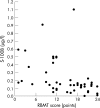Prediction of cognitive dysfunction after resuscitation from out-of-hospital cardiac arrest using serum neuron-specific enolase and protein S-100
- PMID: 17502328
- PMCID: PMC2000934
- DOI: 10.1136/hrt.2006.091314
Prediction of cognitive dysfunction after resuscitation from out-of-hospital cardiac arrest using serum neuron-specific enolase and protein S-100
Abstract
Background: More than 50% of patients initially resuscitated from out-of-hospital cardiac arrest die in hospital.
Objective: To investigate the prognostic value of serum protein S-100 and neuron-specific enolase (NSE) concentrations for predicting (a) memory impairment at discharge; (b) in-hospital death, after resuscitation from out-of-hospital cardiac arrest.
Methods: In a prospective study of 143 consecutive survivors of out-of-hospital cardiac arrest, serum samples were obtained within 12, 24-48 and 72-96 hours after the event. S-100 and NSE concentrations were measured. Pre-discharge cognitive assessment of patients (n = 49) was obtained by the Rivermead Behavioural Memory Test (RBMT). The relationship between biochemical brain marker concentrations and RBMT scores, and between marker concentrations and the risk of in-hospital death was examined.
Results: A moderate negative relationship was found between S-100 concentration and memory test score, at all time points. The relationship between NSE and memory test scores was weaker. An S-100 concentration >0.29 microg/l at time B predicted moderate to severe memory impairment with absolute specificity (42.8% sensitivity). S-100 remained an independent predictor of memory function after adjustment for clinical variables and cardiac arrest timing indices. NSE and S-100 concentrations were greater in patients who died than in those who survived, at all time points. Both NSE and S-100 remained predictors of in-hospital death after adjustment for clinical variables and cardiac arrest timing indices. The threshold concentrations yielding 100% specificity for in-hospital death were S-100: 1.20 microg/l (sensitivity 44.8%); NSE 71.0 microg/l (sensitivity 14.0%).
Conclusions: Estimation of serum S-100 concentration after out-of-hospital cardiac arrest can be used to identify patients at risk of significant cognitive impairment at discharge. Serum S-100 and NSE concentrations measured 24-48 hours after cardiac arrest provide useful additional information.
Conflict of interest statement
Competing interests: Dr NR Grubb was reimbursed for consultancy work for St Jude Medical between 2005 and 2006. He was also reimbursed for consultancy work for CardioDigital, a signal analysis company, between 2003 and 2006. Dr Grubb does not hold shares in either company.
Similar articles
-
Ability of neuron-specific enolase to predict survival to hospital discharge after successful cardiopulmonary resuscitation.CJEM. 2006 Jan;8(1):13-8. doi: 10.1017/s1481803500013324. CJEM. 2006. PMID: 17175624
-
Serum neuron-specific enolase as a prognostic marker for irreversible brain damage in comatose cardiac arrest survivors.Acad Emerg Med. 1996 Feb;3(2):126-31. doi: 10.1111/j.1553-2712.1996.tb03399.x. Acad Emerg Med. 1996. PMID: 8808372
-
Serum neuron specific enolase and malondialdehyde in patients after out-of-hospital cardiac arrest.Cell Mol Neurobiol. 2009 Sep;29(6-7):807-10. doi: 10.1007/s10571-009-9361-y. Epub 2009 Feb 25. Cell Mol Neurobiol. 2009. PMID: 19241153 Free PMC article.
-
Serum Neuron-Specific Enolase Thresholds for Predicting Postcardiac Arrest Outcome: A Systematic Review and Meta-analysis.Neurology. 2022 Jan 4;98(1):e62-e72. doi: 10.1212/WNL.0000000000012967. Epub 2021 Oct 18. Neurology. 2022. PMID: 34663643
-
Biochemical markers (NSE, S-100, IL-8) as predictors of neurological outcome in patients after cardiac arrest and return of spontaneous circulation.Resuscitation. 2007 Nov;75(2):219-28. doi: 10.1016/j.resuscitation.2007.03.016. Epub 2007 May 4. Resuscitation. 2007. PMID: 17482335 Review.
Cited by
-
Changes in S-100 protein serum levels in survivors of out-of-hospital cardiac arrest treated with mild therapeutic hypothermia: a prospective, observational study.Crit Care. 2009;13(2):R58. doi: 10.1186/cc7785. Epub 2009 Apr 16. Crit Care. 2009. PMID: 19368739 Free PMC article.
-
Serum neuron-specific enolase as predictor of outcome in comatose cardiac-arrest survivors: a prospective cohort study.BMC Cardiovasc Disord. 2011 Aug 8;11:48. doi: 10.1186/1471-2261-11-48. BMC Cardiovasc Disord. 2011. PMID: 21824428 Free PMC article.
-
Effects of exogenous hydrogen sulfide on brain metabolism and early neurological function in rabbits after cardiac arrest.Intensive Care Med. 2012 Nov;38(11):1877-85. doi: 10.1007/s00134-012-2714-x. Epub 2012 Sep 26. Intensive Care Med. 2012. PMID: 23011534
-
A panel of neuron-enriched proteins as markers for traumatic brain injury in humans.J Neurotrauma. 2009 Nov;26(11):1867-77. doi: 10.1089/neu.2009.0882. J Neurotrauma. 2009. PMID: 19811094 Free PMC article.
-
Cognitive Impairment among Cardiac Arrest Survivors in the ICU: A Retrospective Study.Emerg Med Int. 2019 Nov 3;2019:2578258. doi: 10.1155/2019/2578258. eCollection 2019. Emerg Med Int. 2019. PMID: 31781396 Free PMC article.
References
-
- Cobb L A, Werner J A, Trobaugh G B. Sudden cardiac death: I. A decade's experience with out‐of‐hospital resuscitation. Mod Concepts Cardiovasc Dis 19804931–36. - PubMed
-
- Schneider T, Martens P R, Paschen H, for the Optimized Response to Cardiac Arrest (ORCA) Investigators et al Multicenter, randomised, controlled trial of 150‐J biphasic shocks compared with 200‐360‐J monophasic shocks in the resuscitation of out‐of‐hospital cardiac arrest victims. Circulation 20001021780–1787. - PubMed
Publication types
MeSH terms
Substances
LinkOut - more resources
Full Text Sources
Medical



